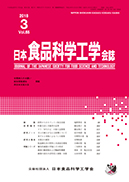
- |<
- <
- 1
- >
- >|
-
(平成29年度日本食品科学工学会技術賞)塩野 貴史, 河合 淳一郎, 山本 研一朗2018 年 65 巻 3 号 p. 99-103
発行日: 2018/03/15
公開日: 2018/03/20
ジャーナル フリーIn recent years, the demand for beverages with lower caffeine concentrations has been expanding. However, traditional decaffeination technologies for tea and coffee not only remove caffeine, but also reduce the active components responsible for beverage flavor and quality. In this study, we investigated the selectivity and versatility of decaffeination by montmorillonite (MMT) in beverages. MMT adsorbed caffeine from tea and coffee extracts more selectively than activated carbon (AC). Optimization of the contact conditions enabled stable decaffeination and prevented elution of Fe ions from MMT, which causes discoloration of tea beverages. MMT exhibited similar caffeine adsorption properties with various types of tea extracts and coffee extracts. In addition, ion-exchanged MMTs, which also removed caffeine, improved the appearance quality of decaffeinated beverages. Overall, our findings suggest that MMT is a useful adsorbent for producing high-quality decaffeinated beverages. Specifically, decaffeinated tea beverages treated with MMT have been commercially available since 2014 from Kirin Beverage Company Ltd.
抄録全体を表示PDF形式でダウンロード (735K)
-
鶴永 陽子, 斉藤 真苗, 安木 健人, 高橋 哲也2018 年 65 巻 3 号 p. 104-110
発行日: 2018/03/15
公開日: 2018/03/20
ジャーナル フリー本研究では,剥皮性にすぐれるものの,加熱加工時に実割れしやすい ‘ぽろたん’ の冷凍果実を用いて甘露煮を製造し,貯蔵条件の違いが甘露煮の品質に及ぼす影響について検討した.その結果,冷凍果実を甘露煮に使用する場合,0℃,1ヶ月程度の冷蔵を行い,剥皮を行ってから冷凍すると実割れ率が低減出来ることが明らかとなった.また,冷凍することで,収穫直後あるいは冷蔵果実を用いた場合よりも最大応力,もろさ応力の低い,すなわち柔らかく歯ごたえの少ない甘露煮に仕上がることが分かった.処理区間の色調への影響は小さかった.さらに,冷凍の際の真空処理により果実の最大応力が高まることも明らかになった.
抄録全体を表示PDF形式でダウンロード (1152K) -
鶴永 陽子, 斉藤 真苗, 安木 健人, 高橋 哲也2018 年 65 巻 3 号 p. 111-117
発行日: 2018/03/15
公開日: 2018/03/20
ジャーナル フリー本研究では,‘ぽろたん’ の冷凍果実を用いた実割れの少ない甘露煮の製造方法を見いだすことを目標とすべく,甘露煮の各製造工程の条件の違いが実割れ率に及ぼす影響について検討した.また,甘露煮のさらなる高品質化のために,製造工程が色調,物性に及ぼす影響についても検討した.その結果,実割れ率を少なくする方法は,茹で処理で剥皮を行い,ミョウバン溶液に10分間以上浸漬したのち,85℃で湯煮および砂糖液煮を行うのが最適と判断された.また,最大応力に影響するのは,剥皮方法,解凍方法,ミョウバン溶液の浸漬時間,加熱温度で,色調に影響するのは剥皮方法,解凍方法,ミョウバン溶液の浸漬時間であることが明らかになった.
抄録全体を表示PDF形式でダウンロード (905K)
-
松井 利博, 白水 智子, 坂口 貴臣, 金谷 太作, 寺澤 和広, 川﨑 健司2018 年 65 巻 3 号 p. 118-123
発行日: 2018/03/15
公開日: 2018/03/20
ジャーナル フリー本研究で筆者らは,硬さの違うガムを噛んだ際の咀嚼効果の検討を行った.「硬ガム」を噛むと刺激時唾液量が「軟ガム」に比べて有意に多いことが確認された.「硬ガム」の咀嚼前後で有意に唾液中の菌数が減少していることが確認された.更に「軟ガム」と「硬ガム」を比較すると,唾液中菌数の減少率に有意な差が認められた.「硬ガム」を噛んだ後の方が噛む前に比べて,認知課題中の脳活動が有意に高くなることが確認された.これらのことから,硬さの異なるガムを噛んだ際の咀嚼効果に対する新たな知見が得られた.食品としてのガムは,硬いガムの方が軟らかいガムより,刺激時の唾液分泌量を増加させ,唾液中の菌数を減少させることが示唆され,口腔衛生への寄与が期待された.硬いガムは日常生活においてQOLを維持向上させる簡便なツールとして活用される可能性が期待された.
抄録全体を表示PDF形式でダウンロード (944K) -
中野 明日香, 粉川 美踏, 北村 豊2018 年 65 巻 3 号 p. 124-129
発行日: 2018/03/15
公開日: 2018/03/20
ジャーナル フリー本実験では,比容積とテクスチャー改善を目的にグルテンフリー米粉パンへの米ゲルの添加を検討した.米ゲルには高アミロース品種であるモミロマンを使用し,白米と玄米それぞれを5つの水分条件で炊飯し,高速せん断撹拌したものを調製した.米ゲル,米粉,水および副材料を混合し,ホームベーカリーを用いてパンを調製し,硬さ·硬さ変化率·比容積·断面写真で評価をした.
製パンの原料配合において,水は大きな割合を占めており,加水量は製パン性やその後のパン品質に大きく影響を与えるため,本実験では,加水量,白米と玄米の違いが製パン性に与える影響を検討した.得られた知見を以下に示す.
·米ゲルは白米,玄米それぞれから調製したものを使用したが,硬さや比容積の点ではほとんど有意差はみられなかった.
·水分量が少ない硬めの米ゲルを使用し,かつ,製パン段階での加水量が多いほど,硬さは小さく,比容積は大きい傾向がみられた.
·硬さ変化率(製造後3日間のパンの硬さの増加率)では,有意差がみられなかった.
·本研究で硬さや比容積の点において,最適水分量だと考えられた全体水分量100%パンについて,断面写真を観察すると気泡が大きく形状が悪いといった問題がみられた.
抄録全体を表示PDF形式でダウンロード (1175K)
-
村勢 則郎2018 年 65 巻 3 号 p. 130-131
発行日: 2018/03/15
公開日: 2018/03/20
ジャーナル フリーPDF形式でダウンロード (245K) -
小國 正晴, 名越 篤史, 庭野 大樹, 川井 清司2018 年 65 巻 3 号 p. 132-141
発行日: 2018/03/15
公開日: 2018/03/20
ジャーナル フリー断熱型熱量計を用いて熱容量とエンタルピー緩和速度を測定することにより,1)シリカMCM-41,2)デキストランゲルsephadex G10,3)水溶性牛血清アルブミン(BSA)それぞれの細孔水の熱挙動を50〜300Kの温度範囲で調べた.3つの細孔壁は,親水性/疎水性,細孔形状,形状柔軟性等において異なる.MCM-41には細孔直径1.5〜5.0nmを用い,過剰量の水を添加した.G10とBSAの測定には,それぞれ水分量(無水物に対する水の質量比)h=0.273と0.321を用いた.MCM-41細孔水は直径2.1nm以下で115,165,210Kの複数の温度付近でガラス転移を示した.115Kは細孔壁に接した界面水分子に因る.後者2つは内部水に因り,細孔径の増大とともに転移温度は階段的に上昇した.各ガラス転移は低温からそれぞれ,配置変化が2,3,4本の水素結合を切断して進行する過程に対応するものと解釈した.G10細孔水が273K付近で取り得る配置の数はバルク水,さらにはMCM-41細孔水に比較しても少ない.室温付近ではゲル高分子自身の配置変化も進行しながら,細孔水に可能な配置数が増大している.BSA細孔水が取り得る配置の数は,室温でも少なく,h=0.321ではBSAの高次構造がBSA分子内の相互作用で決まり,非晶性細孔水は狭い隙間にあることを示唆する.
抄録全体を表示PDF形式でダウンロード (1249K)
-
三宅 眞実, 幸田 知子, 安木 真世, 坂野上 英世, 平田 祥太郎2018 年 65 巻 3 号 p. 142-147
発行日: 2018/03/15
公開日: 2018/03/20
ジャーナル フリーSpores are a highly resistant form of bacteria and are capable of surviving various environmental stresses. When food is contaminated with spores, it can result in food spoilage and food-borne illness. Although it is important to develop procedures to control the germination and outgrowth of food-contaminating spores, there is limited biological information about the spores of anaerobic Clostridium spp. In this mini-review, recent advances in the biological behaviors of Clostridium spp. spores are summarized, and the possible burden in food hygiene induced by putative “damaged-but-viable” spores is discussed. Concerted efforts to elucidate the biological specificity of spores are needed to develop new control measures applicable to a variety of hygienic processes.
抄録全体を表示PDF形式でダウンロード (632K) -
岡本 晋, 亀谷 宏美2018 年 65 巻 3 号 p. 148-153
発行日: 2018/03/15
公開日: 2018/03/20
ジャーナル フリーThe control of microorganisms is one of the most important issues in food preservation. Water activity, temperature, pH and preservatives are all critical factors that affect microbial growth. The application of acid stress (low pH and weak acid preservatives) is widely used to inhibit bacterial growth, as it decreases the internal pH below the normal physiological range. In addition to low pH effects, acid preservatives compromise the functional integrity of the cell membrane, cell wall, metabolic enzymes, protein synthesis system and/or genetic material. Certain bacteria, such as Escherichia coli and Salmonella spp., are equipped with elegant systems that enable survival in acidic environments.
抄録全体を表示PDF形式でダウンロード (770K) -
山本 和貴, 木村 啓太郎, 稲岡 隆史, 森松 和也, 中浦 嘉子2018 年 65 巻 3 号 p. 154-162
発行日: 2018/03/15
公開日: 2018/03/20
ジャーナル フリーFood processing by high hydrostatic pressure (HHP) has several characteristic aspects, including homogeneous and almost spontaneous transmission of pressure; inactivation of viruses and microbes; suppressed deterioration of nutrients, flavors, and pigments; denaturation of food biopolymers such as proteins and starch; enhanced liquid impregnation and air bubble dissolution; and shucking of bivalves and crustaceans. Among these, microbial inactivation has been intensively studied for practical applications in processing agricultural produce with minimal quality loss and reduced risk of pathogenic and/or spoilage microbes, especially bacteria. HHP treatment, as well as other intervention technologies, may inactivate bacteria lethally and sublethally. However, sublethal inactivation of bacteria has not been elucidated sufficiently. This paper reviews bacterial inactivation by HHP with a focus on bacterial injury and recovery.
抄録全体を表示PDF形式でダウンロード (1635K)
- |<
- <
- 1
- >
- >|